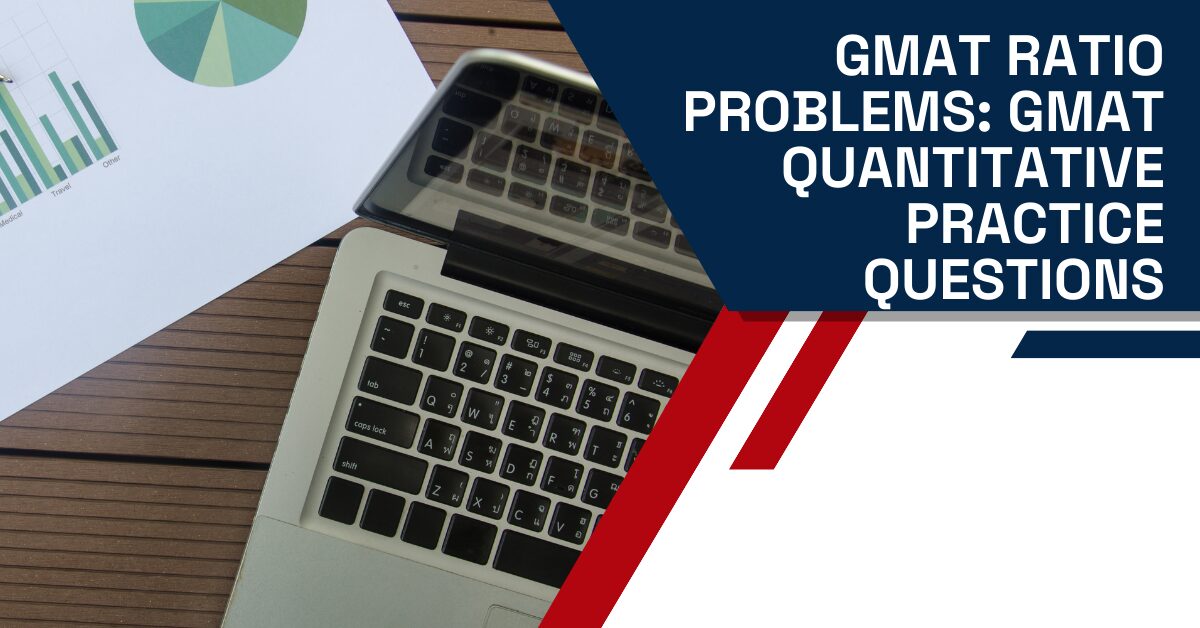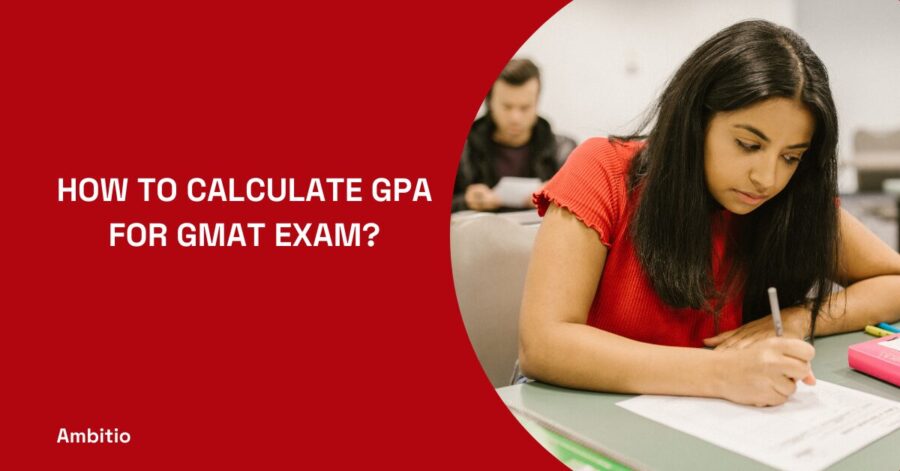3 September 2024
8 minutes read
GMAT Ratio Problems: GMAT Quantitative Practice Questions

Key Takeaways
- Ratios aren’t just math tricks – they’re real-world skills that pop up everywhere from cooking to business.
- Master the basics: identify relationships, set up equations, and cross-multiply when needed.
- Practice is crucial, but understanding the ‘why’ behind each step is what really boosts your score.
- Don’t let complex wording throw you off – break down GMAT ratio problems step-by-step and trust your logic.
Are you gearing up for the GMAT but find yourself stumbling over ratio problems? You’re not alone. Many test-takers struggle with this tricky subset of quantitative questions, often feeling overwhelmed by the complex relationships between numbers and variables.
These problems can be particularly challenging because they require a deep understanding of proportional reasoning and the ability to manipulate ratios effectively.
But don’t let ratio problems dampen your GMAT aspirations! With the right approach and plenty of practice, you can master these questions and boost your Quant score. In this blog, we’ll dive into a series of GMAT questions on ratio, breaking down the strategies you need to tackle them with confidence.
Whether you’re just starting your GMAT journey or looking to refine your skills, these insights will help you approach ratio problems with a clear mind and a winning strategy.
GMAT Math: Ratio & Proportions

Let’s talk about GMAT Math: Ratio & Proportions. This topic is a big deal in the GMAT quant topics. It’s not just about memorizing formulas – it’s about understanding relationships between numbers. You need to have a clear idea of the number of questions in GMAT to get an idea of how much time to spend on each topic as well. Here’s why mastering ratios and proportions is crucial for your GMAT prep:
They’re everywhere in real life
From cooking to finance, ratios pop up daily. The GMAT tests this because it’s practical stuff. You’ll see questions about mixing ingredients or comparing business profits. Getting good at these helps beyond just the test. You can also take a look at GMAT percentage tricks to make certain problems easier.
They’re a gateway to other math concepts
Ratios link to fractions, percentages, and even probability. Nailing ratios makes these other areas easier. It’s like hitting multiple birds with one stone in your GMAT quant prep.
They test your logical thinking
GMAT ratio questions aren’t just about plugging numbers into equations. They make you think critically. You need to analyze the given info and figure out the best approach. This skill is key for the whole GMAT.
They’re often part of word problems
The GMAT loves to hide ratios in wordy questions. Getting good at spotting and extracting the important info is crucial. It’s not just about the math – it’s about your reading comprehension too.
They’re a common stumbling block
Many test-takers struggle with ratios, especially when variables are involved. Mastering this topic can give you an edge. It could be the difference between a good score and a great one on the GMAT math section.
Remember, practice is key. Work through lots of GMAT ratio practice questions. Don’t just aim for the right answer – understand the why behind each step. This approach will serve you well, whether you’re aiming for a 750+ score or just want to boost your quant performance. This is how you can ace the GMAT quant section as well.
GMAT Sample Questions: Topic Wise GMAT Questions

Ratios and proportions form an important part of the GMAT quant section and you need to practice to perfect them. GMAT for non-math background students can be a bit challenging, but practice is the way to go. Here are a few questions to brush up your skills:
Question 1
The ratio of boys to girls in a class is 3:2. If there are 30 students in the class, how many girls are there?
Explanation
To solve this problem, we need to find the number of girls in the class given the ratio of boys to girls.
The ratio of boys to girls is 3:2, which means that for every 5 students, 3 are boys and 2 are girls.
Since there are 30 students in the class, we can divide 30 by 5 to find the number of groups of 5 students:
- 30 ÷ 5 = 6 groups
Each group has 2 girls, so the total number of girls in the class is:
- 6 groups × 2 girls per group = 12 girls
Therefore, there are 12 girls in the class.
Question 2
The ratio of the number of apples to the number of oranges in a basket is 5:3. If there are 40 pieces of fruit in the basket, how many oranges are there?
Explanation
To solve this problem, we need to find the number of oranges in the basket given the ratio of apples to oranges.
The ratio of apples to oranges is 5:3, which means that for every 8 pieces of fruit, 5 are apples and 3 are oranges.
Since there are 40 pieces of fruit in the basket, we can divide 40 by 8 to find the number of groups of 8 pieces of fruit:
- 40 ÷ 8 = 5 groups
Each group has 3 oranges, so the total number of oranges in the basket is:
- 5 groups × 3 oranges per group = 15 oranges
Therefore, there are 15 oranges in the basket.
Question 3
The ratio of the number of boys to the number of girls in a school is 3:2. If the total number of students in the school is 750, how many boys are there in the school?
Explanation
To solve this problem, we need to find the number of boys in the school given the ratio of boys to girls.
The ratio of boys to girls is 3:2, which means that for every 5 students, 3 are boys and 2 are girls.
Since the total number of students in the school is 750, we can divide 750 by 5 to find the number of groups of 5 students:
- 750 ÷ 5 = 150 groups
Each group has 3 boys, so the total number of boys in the school is:
- 150 groups × 3 boys per group = 450 boys
Therefore, there are 450 boys in the school.
Question 4
The ratio of the number of pens to the number of pencils in a box is 2:3. If there are 25 writing instruments in the box, how many pens are there?
Explanation
To solve this problem, we need to find the number of pens in the box given the ratio of pens to pencils.
The ratio of pens to pencils is 2:3, which means that for every 5 writing instruments, 2 are pens and 3 are pencils. Since there are 25 writing instruments in the box, we can divide 25 by 5 to find the number of groups of 5 writing instruments:
- 25 ÷ 5 = 5 groups
Each group has 2 pens, so the total number of pens in the box is:
- 5 groups × 2 pens per group = 10 pens
Therefore, there are 10 pens in the box.
Question 5
The ratio of the number of red balls to the number of blue balls in a bag is 4:3. If there are 21 balls in the bag, how many blue balls are there?
Explanation
To solve this problem, we need to find the number of blue balls in the bag given the ratio of red balls to blue balls. The ratio of red balls to blue balls is 4:3, which means that for every 7 balls, 4 are red and 3 are blue. Since there are 21 balls in the bag, we can divide 21 by 7 to find the number of groups of 7 balls:
- 21 ÷ 7 = 3 groups
Each group has 3 blue balls, so the total number of blue balls in the bag is:
- 3 groups × 3 blue balls per group = 9 blue balls
Therefore, there are 9 blue balls in the bag.
How to solve GMAT Ratio and Proportion Problems?
The purpose of the GMAT exam is to identify the skills and potentials of the test takers. Ratio and proportion problems are a common feature of the GMAT Quantitative section, testing your ability to understand and manipulate relationships between quantities. Here’s a concise guide to help you tackle these problems effectively:
Understanding Ratios and Proportions
Ratios compare two quantities, while proportions are equations stating that two ratios are equal.
Relevant Tips for GMAT Test Prep
Familiarize yourself with different types of ratio and proportion questions. Understand the importance of GMAT exam and approach it the same way. Practice with GMAT practice tests and free GMAT resources available online to sharpen your skills.
Solving Strategy
Clearly understand what the problem is asking and how ratios or proportions are involved.
- Translate the problem into mathematical equations using the given ratios or proportions.
- Use algebraic techniques such as cross-multiplication or setting up equivalent fractions to find the unknown quantities.
Keyword Integration
Practice tests and diagnostic exams can help you identify areas needing improvement, whether it’s in geometry, algebra, or integer properties. Aim for a score of 700 or higher by mastering these fundamental concepts.
Application in MBA and GRE Courses
Proficiency in ratio and proportion problem-solving is crucial not only for the GMAT but also for related exams like the GRE. These skills are valuable in fields such as finance, statistics, and business analytics.
Understanding how to handle ratio and proportion problems efficiently can significantly boost your GMAT performance. Practice regularly and utilize available resources to enhance your skills before taking the test. Take a look at the colleges accepting GMAT score and determine the score range you want to achieve.
GMAT Tips: Proportions, Ratios and Rates
Understanding proportions, ratios, and rates is crucial for mastering the GMAT Quantitative section. Here’s a guide to help you navigate through these topics effectively:
Exploring Proportions, Ratios, and Rates
These concepts are foundational in quantitative reasoning on the GMAT. Proportions compare equivalent ratios, while rates involve comparing quantities with different units, often per unit of time or another measure.
Relevant Tips for GMAT Test Prep
GMAT is an adaptive test. Practice solving GMAT sample questions from these topics to familiarize yourself with their application in real exam scenarios. Focus on understanding how to calculate percentages, which often appear in ratio problems on the GMAT Quant section. Also, choose the right GMAT books for your prep. Properly understand the benefits of GMAT and go ahead with the process. You can choose a GMAT beginners guide if you are brand new to it.
Solving Strategy
Recognize different question formats in ratio and proportion problems, such as finding proportional relationships or determining resultant quantities.
- Use algebraic and mathematical methods to solve tricky problems efficiently. Break down complex ratios into simpler terms for easier calculation.
- Regularly review GMAT quant topics related to proportions, ratios, and rates to reinforce your understanding and improve accuracy.
- GMAT ratio problems and questions involving percentages are integral to the quant section. Master these concepts through thorough practice and review to excel in this portion of the exam.
Understanding how to manipulate proportions, ratios, and rates mathematically will enhance your ability to solve quantitative problems on the GMAT effectively. Practice with GMAT sample questions and stay consistent in your preparation to achieve your target score.
Conclusion
Ratio problems don’t have to be your GMAT nemesis. With consistent practice and the right mindset, you’ll start seeing patterns and solving these questions more efficiently. Remember, it’s not just about getting the right answer—it’s about understanding the underlying concepts.
As you continue your GMAT prep, don’t shy away from ratio questions. Embrace them as opportunities to sharpen your skills. And hey, who knows? You might even start to enjoy the challenge. Keep at it, and you’ll be tackling these problems like a pro in no time.
Maximize your GMAT potential and aim for the top with Ambitio’s comprehensive prep tools. Our approach focuses on enhancing your strengths and addressing your weaknesses, providing you with the skills and confidence needed to score higher and reach your MBA goals.
FAQs
What’s the most common mistake people make with GMAT ratio problems?
Rushing to calculate without fully understanding the relationship. Always take a moment to clearly identify what’s being compared before crunching numbers.
How can I improve my speed in solving ratio questions?
Practice, practice, practice. But focus on understanding patterns. The more you do, the quicker you’ll recognize question types and know which approach to use.
Are there any shortcuts for tackling proportion problems on the GMAT?
Cross-multiplication is often the fastest way. Set up your proportion and multiply diagonally. It’s simple but effective for many GMAT proportion questions.
How often do ratio and proportion questions appear on the GMAT?
They’re pretty common. You can expect to see 3-5 questions on ratios and proportions in the Quant section. They’re considered fundamental, so prepare well.
Can you explain the difference between a ratio and a proportion?
A ratio compares two quantities (like 3:5), while a proportion states that two ratios are equal (like 3/5 = 6/10). Proportions are essentially equations of ratios.
What’s the best way to practice GMAT ratio problems?
Use official GMAT prep materials and practice tests. They’ll give you the most accurate feel for how these questions are presented on the real exam.
How do ratio problems on the GMAT differ from those on the GRE?
GMAT ratio problems tend to be more complex and business-oriented. They often require more steps and might include variables, while GRE questions are usually more straightforward.

You can study at top universities worldwide!
Get expert tips and tricks to get into top universities with a free expert session.
Book Your Free 30-Minute Session Now! Book a call now




























